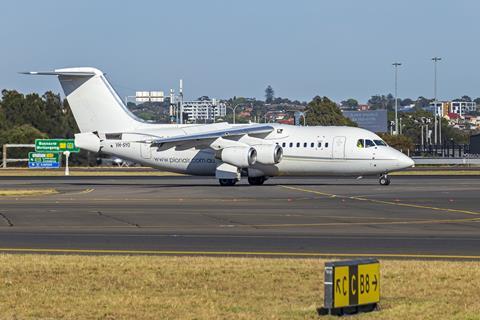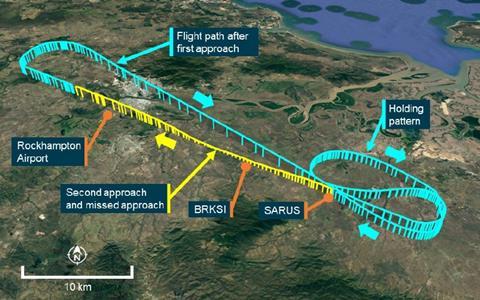Fatigue has been identified as a contributor to a 5 January incident in which a British Aerospace BAe 146 freighter flew below minimum safe altitude as it approached Rockhampton in Queensland.
The serious incident occurred just before 04:00 local time as the aircraft (VH-SFV), operated by Pionair Australia, made a second approach to Rockhampton’s runway 33, says the Australian Transport Safety Bureau. The aircraft was operating from Brisbane.

Following a previous missed approach, the jet entered the holding pattern at 3,500ft before being cleared for a second landing attempt.
Normal practice for a straight-in approach was to descend to cross the initial approach fix, the SARUS waypoint, at 5,000ft, says the ATSB, then continue descending to the next waypoint, BRKSI, while remaining above the segment minium safe altitude (SMSA) of 3,000ft.
But due to the hold at 3,500ft, the aircraft passed through the SARUS waypoint at the lower altitude and ”the captain commenced descending as per their normal practice”, says the agency.
This led to the aircraft descending below the 3,000ft SMSA prior to crossing the BRKSI waypoint, states the report. ”The aircraft continued descending on about a 3° approach profile and crossed BRKSI at 1,705ft (1,295ft below the SMSA) before then descending below the next SMSA of 1,500ft, 24 seconds later,” says the ATSB.
“As the aircraft continued descending toward the [minimum descent altitude], along a descent profile consistent with it being one approach segment further along than it actually was, the flightcrew recognised that the ground lighting appeared different to the first approach and that distance measuring equipment indications were not as expected,” says the ATSB’s final report on the incident.
“In response, the first officer looked at the flight management computer and identified that the next waypoint was BRKSF, not the expected missed approach point, and immediately called for the captain to conduct a missed approach.”
At roughly that moment the ground proximity warning system generated a ‘terrain’ alert. The inquiry found that that the minimum recorded height during the approach was 602ft above ground level. The crew then diverted to Mackay, Queensland.
The ATSB found that even though the crew had experience operating the Brisbane-Rockhampton route, neither the captain nor first officer had taken sufficient sleep, having completed 9h of duty at 04:45 on 4 January.
The crew’s workload on the second approach was also high.

Another factor was the aircraft’s arrival time at Rockhampton, which corresponds with a period when human alertness is known to be lower. In addition, Pionair’s rostering may have contributed to the crew’s sleep challenges.
“Both crew members reported that inconsistent and varying rosters reduced their ability to achieve sufficient and good quality sleep,” says the ATSB.
“Prior to departure, the captain and first officer discussed the difficulty in obtaining sleep the previous day. The captain recalled feeling moderately tired, although neither crewmember reported feeling unfit for duty or felt the need to make a fatigue report prior to commencing duty.”
Following the incident, Pionair set up a fatigue safety action group. Between May and July it reduced operational workloads while it trained additional flight crew. Changes were also made to manuals and training procedures.
Pionair operates passenger and cargo services from Sydney’s Bankstown Airport. Cirium fleets data indicates that the aircraft was originally delivered in 1988 to TNT Express Worldwide. It served with several carriers before joining Pionair in 2016.
In November 2020, Express Freighters Australia, a unit of Qantas Freight, wet leased the aircraft.










































